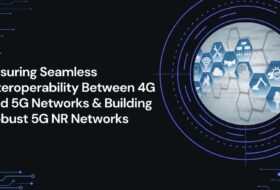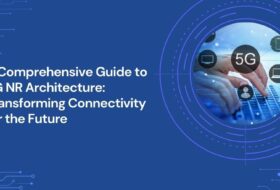Introduction
Voice over 5G (Vo5G) is positioned to transform how we experience voice services by leveraging the strengths of 5G technology, such as ultra-low latency, network slicing, and massive device connectivity. However, deploying Vo5G in real-world settings is complex and comes with several technical hurdles. This article thoroughly examines these challenges, detailing the underlying technologies and strategies used to address them, and includes real-world examples of Vo5G deployments in diverse sectors.
1. Detailed Examination of Vo5G Deployment Challenges
- Latency Requirements for Real-Time Vo5G Calls
Latency, the delay in data transmission, is especially sensitive in voice communication. To maintain real-time conversations, Vo5G networks aim for end-to-end latency below 20ms, a challenging target when dealing with high network load or in areas with suboptimal coverage.
In-Depth Technical Process:
- Packet Routing and Priority Handling: Unlike traditional packet handling, Vo5G traffic prioritizes voice packets using the 5G Quality of Service (QoS) Class Identifiers (QCIs). This prioritization helps avoid delays during peak traffic.
- Network Slicing for Guaranteed Bandwidth: 5G core networks allow for dedicated network slices tailored to different types of services. A slice created for Vo5G has specific latency and bandwidth allocations, ensuring that voice packets avoid delays commonly encountered by data packets.
- Ultra-Reliable Low-Latency Communication (URLLC): Part of the 5G NR standard, URLLC is designed to support applications with stringent latency requirements. By allocating resources specifically for ultra-reliable transmission, URLLC ensures that Vo5G calls do not experience jitter or packet drops.
Example: In a dense urban deployment in Seoul, operators faced latency issues during festival events where the network was highly congested. By activating a dedicated URLLC slice for Vo5G and redirecting some data traffic to non-critical slices, engineers successfully reduced latency and provided stable, real-time communication for Vo5G users attending the event.
- Handover Complexity in Vo5G: Ensuring Seamless Call Transition
In Vo5G, handover refers to the process of shifting an ongoing call between cells or networks, such as from 5G to LTE in NSA (Non-Standalone) deployments. For mobile users, especially those moving at high speeds, maintaining a seamless handover is technically challenging.
In-Depth Technical Process:
- Measurement Reports and Threshold-Based Handover: Vo5G devices frequently measure signal strength, sending these reports to the network. Based on pre-set thresholds, the network predicts when a handover is needed. For high-speed scenarios, these thresholds are adjusted dynamically to allow early handovers.
- Make-Before-Break (MBB) Strategy: This strategy involves establishing a connection to the new cell before the old one is released. In Vo5G, MBB is critical as it helps prevent call drops during handover, especially in high-speed environments like highways or public transit systems.
- Dual Connectivity in NSA Deployments: For NSA 5G networks, handovers often rely on dual connectivity, where a device is connected to both LTE and 5G. As the user moves, the network can seamlessly shift data transmission between LTE and 5G to maintain continuity.
Example: In a pilot project on Tokyo’s Shinkansen, the high-speed rail network, Vo5G users faced significant handover disruptions due to the extreme speeds. Engineers adapted the handover thresholds and implemented MBB, which allowed users to stay connected as the system established the next cell connection before releasing the old one. This improved handover success rates and reduced call drops on the Shinkansen.
- Fallback Mechanisms to LTE in NSA Vo5G Networks
Since most early Vo5G deployments operate in NSA mode, they rely heavily on LTE infrastructure to maintain coverage in areas with weak or absent 5G signals. This fallback process must be smooth, transparent, and quick enough to prevent users from noticing the shift.
In-Depth Technical Process:
- Dual Connectivity for Simultaneous Network Access: In NSA networks, devices can connect to both 4G LTE and 5G simultaneously. When 5G signal weakens, dual connectivity allows for a rapid, almost unnoticeable switch to LTE.
- Radio Resource Control (RRC) Protocols: RRC is used for signaling between the device and the network. For fallback, RRC signaling initiates a transition to LTE while keeping the user’s session active. Vo5G deployments use an enhanced version of RRC to accelerate this fallback process.
- Single Radio Voice Call Continuity (SRVCC): SRVCC is a protocol that ensures continuity of a voice call when switching from 5G to LTE. By setting up a seamless path for the call to move to LTE, SRVCC minimizes interruptions during the fallback process.
Example: During a Vo5G deployment in New Zealand’s rural areas, engineers noticed call quality dropped significantly when users transitioned from 5G to LTE. After analyzing the root cause, they enhanced the SRVCC settings and optimized RRC configurations to improve fallback response time. As a result, Vo5G users in these rural zones experienced a much smoother transition with minimal quality degradation.
- Quality of Service (QoS) for Vo5G: Managing Network Performance Dynamically
Vo5G requires a high level of QoS to deliver clear, uninterrupted voice service. Ensuring consistent QoS, especially in areas with mixed 5G and LTE infrastructure, involves dynamic monitoring and adjustment based on real-time conditions.
In-Depth Technical Process:
- Dynamic QoS Profiles: Vo5G networks assign a QoS profile to each call, which sets parameters like packet delay, jitter, and priority. These profiles are dynamically adjusted based on network load and signal quality.
- Real-Time Monitoring and AI-Based Prediction Models: Many Vo5G deployments employ AI-driven monitoring systems that analyze real-time QoS data, predicting potential drops in quality. Based on this prediction, the system preemptively adjusts network settings or reroutes voice packets to avoid quality degradation.
- Network Functions Virtualization (NFV): NFV allows network resources to be allocated flexibly. In cases of high network congestion, NFV helps reallocate resources toward the Vo5G slice, ensuring that voice calls receive the highest priority.
Example: A cross-border Vo5G deployment in Europe faced QoS issues as users moved across networks with varying standards. Engineers implemented a real-time AI monitoring solution that continuously tracked QoS metrics and adjusted routing or fallback settings. This system ensured consistent voice quality across borders, even as users moved between countries with different network conditions.
2. Expanded Real-World Vo5G Use Cases
- Enterprise Communications: Leveraging Vo5G for High-Quality Business Communication
Detailed Use Case: An international consulting firm deployed Vo5G to enhance teleconferencing quality across global teams. The firm experienced connection stability issues when transitioning between high-density and low-density network areas. By leveraging dynamic network slicing and applying QoS adjustments for voice prioritization, the firm achieved stable, high-quality teleconferencing, which improved collaboration efficiency and client interaction.
- Emergency Services and Public Safety: Priority Access and Reliability with Vo5G
Detailed Use Case: In California, during a wildfire response drill, a Vo5G network dedicated a slice exclusively to first responders. Engineers observed that indoor areas with thick walls caused call drops. By deploying small cells and prioritizing fallback to LTE in areas where 5G coverage was limited, they ensured that emergency personnel maintained a reliable communication link, even in buildings where 5G coverage fluctuated.
- Rural Connectivity: Vo5G as an Alternative to Traditional Telephony
Conclusion
Deploying Vo5G in real-world scenarios requires a robust technical foundation, meticulous planning, and continual optimization. By addressing challenges around latency, handovers, fallback mechanisms, and QoS, operators can unlock Vo5G’s potential, offering unparalleled voice quality and reliability across diverse environments. Real-world examples show that while Vo5G deployment is complex, ongoing innovations in network slicing, dual connectivity, and AI-driven monitoring are paving the way for a fully connected, high-quality voice communication future.
Knowledge of eMBB, URLCC, MMTC.
5G RAN ARCHITECTURE, NR NSA mobility, Massive Mimo, Beamforming, 5G Frame structure, Ultra lean design, 5G QOS compare with LTE, Ericsson & Huawei RAN system for 5G. 5G planning Knowledge.
RF Planning & Optimization in LTE & VOLTE Network
Planning new LTE Macro & IBS sites.
• Cluster-based RF optimization
• Preparation of CDD for LTE network. PCI & RSN planning.
• Analysis of LTE Radio KPIs, investigation, and improvement of network quality problems.
• Implementation of new features and tuning LTE radio network parameters.
• LTE Cell planning, coverage predictions, traffic dimensioning, interference analysis, optimization of the Radio Access Networks in accordance with TRA.
• Forecasts and studies to determine future Radio Base Station and network capacity needs.
• Optimisation of newly integrated LTE sites and expansions, and focus areas.
• Technical investigations of the LTE Radio Access Network; accessibility, capacity and retain ability studies.
• Getting LTE Sites accepted from the customer RF planning team.
You Might Also Like







